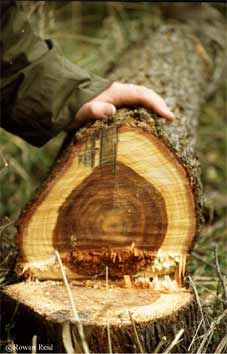|
Observation and exploration

A group of professional foresters inspecting
a young blackwood plantation began debating whether the trees
would contain any heartwood. No one in the group knew of any
research into heartwood formation and colour in young blackwood
trees. The farmer picked up his chainsaw and opened a young
pruned tree cutting lengthways to expose the radial face and
old pruning wounds. Deep-brown heartwood occupied the first
few years growth and the pruning wounds had healed well, allowing
clearwood to form. This simple observation extended the knowledge
of all those present.
There is always something to learn from observation
and exploration. Digging a soil pit can help in determining
the need for deep ripping or provide an explanation for poor
growth. Examining pasture species or crop development beside
a shelterbelt can indicate the extent of the tree roots. Simple
bores can show fluctuations in the height of saline watertables
and the impact of trees on recharge. Going out in the paddock
during a heavy storm can provide insight into how a gully
erodes. Noting the location of stock camps and observing animal
behaviour during hot or cold weather can help farmers design
effective shelterbelt systems.
Searching out references and talking with other
farmers or professionals can help farmers interpret observations
and draw practical conclusions based on sound scientific principles.
Back to top
|
